“In Situ” Formation of Zn Anode from Bimetallic Cu-Zn Alloy (Brass) for Dendrite-Free Operation of Zn-Air Rechargeable Battery
Abstract
:1. Introduction
2. Experimental
2.1. Materials
2.2. XRF Characterization of the Brass
2.3. Electrodes
2.4. Potentiostat
2.5. Scanning Electron Microscopy (SEM)
2.6. The 3D-Printed Battery and the Electrolytes
3. Results and Discussion
3.1. Cyclic Voltammetry
3.2. Cycling Test of the Zn-Air Battery
3.3. Mathematical Modeling of Discharging Processes
3.4. Morphology
4. Conclusions
Supplementary Materials
Author Contributions
Funding
Informed Consent Statement
Data Availability Statement
Conflicts of Interest
References
- Larcher, D.; Tarascon, J.M. Towards greener and more sustainable batteries for electrical energy storage. Nat. Chem. 2015, 7, 19–29. [Google Scholar] [CrossRef] [PubMed]
- Majumdar, D.; Mandal, M.; Bhattacharya, S.K. Journey from supercapacitors to supercapatteries: Recent advancements in electrochemical energy storage systems. Emergent Mater. 2020, 3, 347–367. [Google Scholar] [CrossRef]
- Girishkumar, G.; McCloskey, B.; Luntz, A.C.; Swanson, S.; Wilcke, W. Lithium-air battery: Promise and challenges. J. Phys. Chem. Lett. 2010, 1, 2193–2203. [Google Scholar] [CrossRef]
- Clark, S.; Latz, A.; Horstmann, B. A Review of Model-Based Design Tools for Metal-Air Batteries. Batteries 2018, 4, 5. [Google Scholar] [CrossRef] [Green Version]
- Buckingham, R.; Asset, T.; Atanassov, P. Aluminum-air batteries: A review of alloys, electrolytes and design. J. Power Sources 2021, 498, 229762. [Google Scholar] [CrossRef]
- Xiong, M.; Clark, M.P.; Labbe, M.; Ivey, D.G. A horizontal zinc-air battery with physically decoupled oxygen evolution/reduction reaction electrodes. J. Power Sources 2018, 393, 108–118. [Google Scholar] [CrossRef]
- Liu, X.; Wang, L.; Yu, P.; Tian, C.; Sun, F.; Ma, J.; Li, W.; Fu, H. A Stable Bifunctional Catalyst for Rechargeable Zinc–Air Batteries: Iron–Cobalt Nanoparticles Embedded in a Nitrogen-Doped 3D Carbon Matrix. Angew. Chem. Int. Ed. 2018, 57, 16166–16170. [Google Scholar] [CrossRef]
- Arico, A.S.; Bruce, P.; Scrosati, B.; Tarascon, J.M.; Schalkwijk, W. Nanostructured materials for advanced energy conversion and storage devices. Nat. Mater. 2005, 4, 366–377. [Google Scholar] [CrossRef]
- Armand, M.; Tarascon, J.M. Building better batteries. Nature 2008, 451, 652–657. [Google Scholar] [CrossRef]
- Han, C.; Cao, W.Q.; Cao, M.-S. Hollow nanoparticle-assembled hierarchical NiCo2O4 nanofibers with enhanced electrochemical performance for lithium-ion batteries. Inorg. Chem. Front. 2020, 7, 4101–4112. [Google Scholar] [CrossRef]
- Yao, L.-H.; Cao, W.-Q.; Shu, J.-C.; Cao, M.-S.; Sun, X.-D. Tailoring adsorption for tunable lithium ion storage and devices. Chem. Eng. J. 2021, 413, 127428. [Google Scholar] [CrossRef]
- Wang, L.; Snihirova, D.; Deng, M.; Vaghefinazari, B.; Xu, W.; Höche, D.; Lamaka, S.V.; Zheludkevich, M.L. Sustainable aqueous metal-air batteries: An insight into electrolyte system. Energy Storage Mater. 2022, 52, 573–597. [Google Scholar] [CrossRef]
- Zhang, J.; Zhou, Q.; Tang, Y.; Zhang, L.; Li, Y. Zinc–air batteries: Are they ready for prime time? Chem. Sci. 2019, 10, 8924–8929. [Google Scholar] [CrossRef] [PubMed] [Green Version]
- Lee, J.S.; Kim, S.T.; Cao, R.; Choi, N.S.; Liu, M.; Lee, K.T.; Cho, J. Metal-air batteries with high energy density: Li-air versus Zn-Air. Adv. Energy Mater. 2010, 1, 34–50. [Google Scholar] [CrossRef]
- Zuoa, Y.; Wang, K.; Pei, P.; Wei, M.; Liua, X.; Xiao, Y.; Zhang, P. Zinc dendrite growth and inhibition strategies. Mater. Today Energy 2021, 20, 100692. [Google Scholar] [CrossRef]
- Shimizu, M.; Hirahara, K.; Arai, S. Morphology control of zinc electrodeposition by surfactant addition for alkaline-based rechargeable batteries. Phys. Chem. Chem. Phys. 2019, 21, 7045–7052. [Google Scholar] [CrossRef]
- Kim, M.; Yun, D.; Jeon, J. Effect of a bromine complex agent on electrochemical performances of zinc electrodeposition and electrodissolution in Zinc-Bromide flow battery. J. Power Sources 2019, 438, 227020. [Google Scholar] [CrossRef]
- Jiang, Y.; Deng, Y.P.; Fu, J.; Lee, D.U.; Liang, R.; Cano, Z.P.; Liu, Y.; Bai, Z.; Hwang, S.; Yang, L.; et al. Interpenetrating Triphase Cobalt-Based Nanocomposites as Efficient Bifunctional Oxygen Electrocatalysts for Long-Lasting Rechargeable Zn-Air Batteries. Adv. Energy Mater. 2018, 8, 1702900. [Google Scholar] [CrossRef]
- Work, A.K.; Ayele, D.W.; Habtu, N.G. Recent advances and future perspectives in engineering of bifunctional electrocatalysts for rechargeable zinc–air batteries. Mater. Today Adv. 2021, 9, 100116. [Google Scholar] [CrossRef]
- Poolnapol, L.; Kao-ian, W.; Somwangthanaroj, A.; Mahlendorf, F.; Nguyen, M.T.; Yonezawa, T.; Kheawhom, S. Silver Decorated Reduced Graphene Oxide as Electrocatalyst for Zinc-Air Batteries. Energies 2020, 13, 462. [Google Scholar] [CrossRef]
- Wang, Y.J.; Fan, H.; Ignaszak, A.; Zhang, L.; Shao, S.; Wilkinson, D.P.; Zhang, J. Compositing doped-carbon with metals, non-metals, metal oxides, metal nitrides and other materials to form bifunctional electrocatalysts to enhance metal-air battery oxygen reduction and evolution reactions. Chem. Eng. J. 2018, 348, 416–437. [Google Scholar] [CrossRef]
- Nagy, T.; Nagy, L.; Erdélyi, Z.; Baradács, E.; Deák, G.; Zsuga, M.; Kéki, S. Environmentally friendly Zn-air rechargeable battery with heavy metal free charcoal based air cathode. Electrochim. Acta 2021, 368, 137592. [Google Scholar] [CrossRef]
- Zhao, S.; Player, L.C.; Bartlett, S.A.; Masters, A.F.; Maschmeyer, T. The Influence of Pyridinium-Based Additives on Zinc Electrodeposition in Aqueous Solution. J. Electrochem. Soc. 2019, 166, D192. [Google Scholar] [CrossRef]
- Kim, H.I.; Shin, H.C. SnO additive for dendritic growth suppression of electrolytic zinc. J. Alloys Compd. 2015, 645, 7–10. [Google Scholar] [CrossRef]
- Xu, Z.; Fan, Q.; Li, Y.; Wang, J.; Lund, P.D. Review of zinc dendrite formation in zinc bromine redox flow battery. Renew. Sustain. Energy Rev. 2020, 127, 109838. [Google Scholar] [CrossRef]
- Garcia, G.; Ventosa, E.; Schuhmann, W. Complete Prevention of Dendrite Formation in Zn Metal Anodes by Means of Pulsed Charging Protocols. ACS Appl. Mater. Interfaces 2017, 9, 18691–18698. [Google Scholar] [CrossRef]
- Wang, K.; Pei, P.; Ma, Z.; Chen, H.; Xu, H.; Chena, D.; Wang, X. Dendrite growth in the recharging process of zinc-air batteries. J. Mater. Chem. A 2015, 3, 22648–22655. [Google Scholar] [CrossRef]
- Nagy, T.; Nagy, L.; Erdélyi, Z.; Baradács, E.; Deák, G.; Zsuga, M.; Kéki, S. Environmentally friendly high performance Zn-air rechargeable battery using cellulose derivatives: A 3D-printed prototype. J. Energy Storage 2022, 49, 104173. [Google Scholar] [CrossRef]
- Liu, Y.; Gao, D.; Xiang, H.; Feng, X.; Yu, Y. Research Progress on Copper-Based Current Collector for Lithium Metal Batteries. Energy Fuels 2021, 35, 12921–12937. [Google Scholar] [CrossRef]
- Ran, Q.; Shi, H.; Meng, H.; Zeng, S.P.; Wan, W.B.; Zhang, W.; Wen, Z.; Lang, X.Y.; Jiang, Q. Aluminum-copper alloy anode materials for high-energy aqueous aluminum batteries. Nat. Commun. 2022, 13, 576. [Google Scholar] [CrossRef]
- Jin, Y.; Chen, F.; Lei, Y.; Wu, X. A Silver-Copper Alloy as an Oxygen Reduction Electrocatalyst for an Advanced Zinc-Air Battery. ChemCatChem 2015, 7, 2377–2383. [Google Scholar] [CrossRef]
- Tan, X.F.; Belyakov, S.A.; Su, T.C.; Gu, Q.; Liu, S.; McDonald, S.D.; Gourlay, C.M.; Yasuda, H.; Matsumura, S.; Nogita, K. Rapid fabrication of tin-copper anodes for lithium-ion battery applications. J. Alloys Compd. 2021, 867, 159031. [Google Scholar] [CrossRef]
- Marioli, J.M.; Kuwana, T. Electrochemical characterization of carbohydrate oxidation at copper electrodes. Electrochim. Acta 1992, 37, 1187–1197. [Google Scholar] [CrossRef]
- He, J.-B.; Lu, D.-Y.; Jin, G.-P. Potential dependence of cuprous/cupric duplex film growth on copper electrode in alkaline media. Appl. Surf. Sci. 2006, 253, 689–697. [Google Scholar] [CrossRef]
- King, F. Corrosion of Copper in Alkaline Chloride Environments; Technical Report, 1404-0344 Contract No.: SKB-TR--02-25; Swedish Nuclear Fuel and Waste Management Co.: Stockholm, Sweden, 2002. [Google Scholar]
- Li, Y.; Lu, J. Metal–Air Batteries: Will They Be the Future Electrochemical Energy Storage Device of Choice? ACS Energy Lett. 2017, 2, 1370–1377. [Google Scholar] [CrossRef]
- Wang, X.; Gao, J.; Cheng, Z.; Chen, N.; Qu, L. A Responsive Battery with Controlled Energy Release. Angew. Chem. Int. Ed. 2016, 55, 14643–14647. [Google Scholar] [CrossRef] [PubMed]
- Lin, C.; Shinde, S.S.; Wang, Y.; Sun, Y.; Chen, S.; Zhang, H.; Li, X.; Lee, J.H. Flexible and rechargeable Zn–air batteries based on green feedstocks with 75% round-trip efficiency. Sustain. Energy Fuels 2017, 1, 1909–1914. [Google Scholar] [CrossRef]
- Nazarov, A.; Thierry, D. Application of Volta potential mapping to determine metal surface defects. Electrochim. Acta 2007, 52, 7689–7696. [Google Scholar] [CrossRef]
- Campagna, N.; Castiglia, V.; Miceli, R.; Mastromauro, R.A.; Spataro, C.; Trapanese, M.; Viola, F. Battery Models for Battery Powered Applications: A Comparative Study. Energies 2020, 13, 4085. [Google Scholar] [CrossRef]
- Shepherd, C.M. Design of Primary and Secondary Cells: II. An Equation Describing Battery Discharge. J. Electrochem. Soc. 1965, 112, 657. [Google Scholar] [CrossRef]
- Peng, Y.; Lai, C.; Zhang, M.; Liu, X.; Yin, Y.; Li, Y.; Wu, Z. Zn–Sn alloy anode with repressible dendrite grown and meliorative corrosion resistance for Zn-air battery. J. Power Sources 2022, 526, 231173. [Google Scholar] [CrossRef]
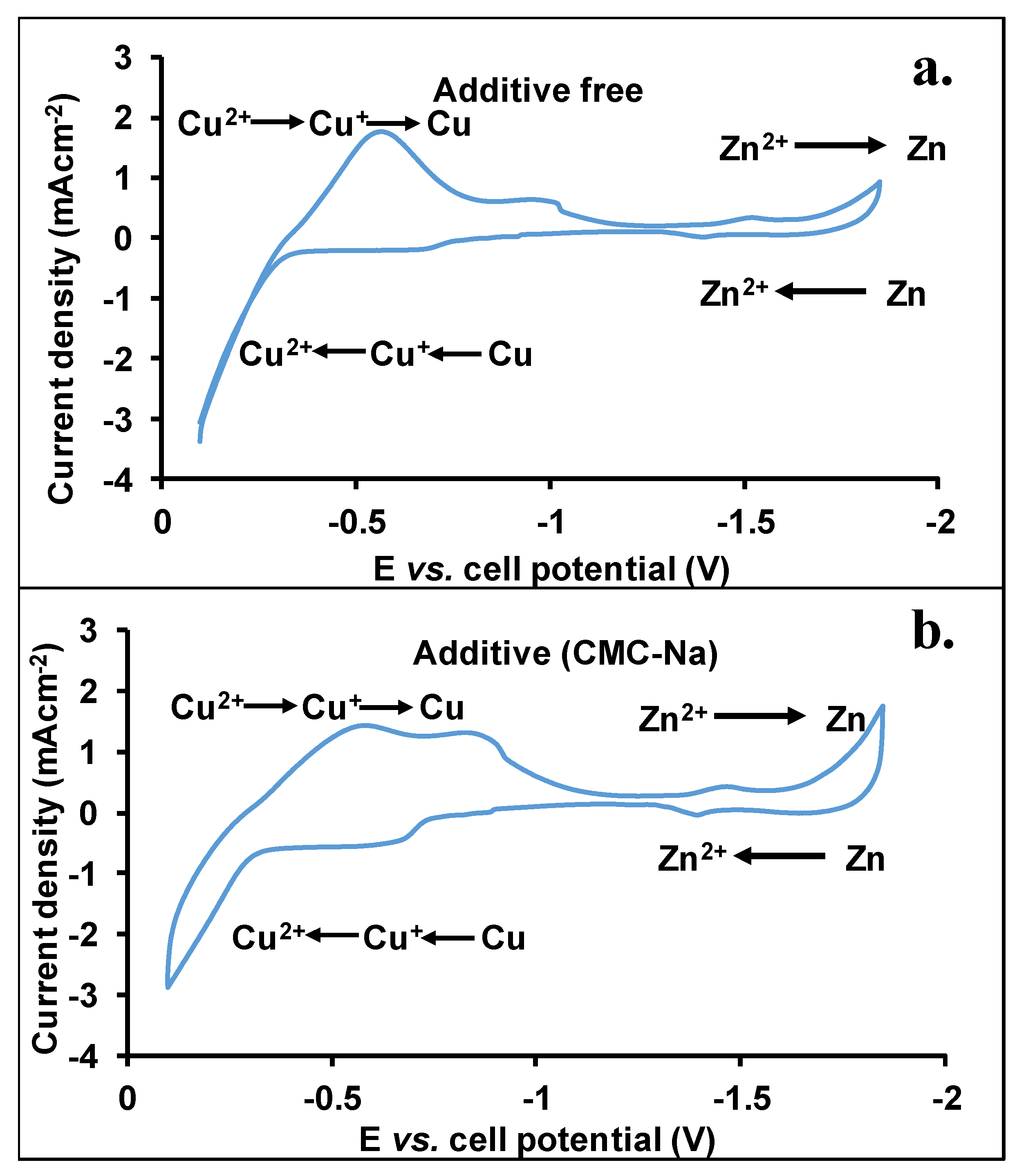
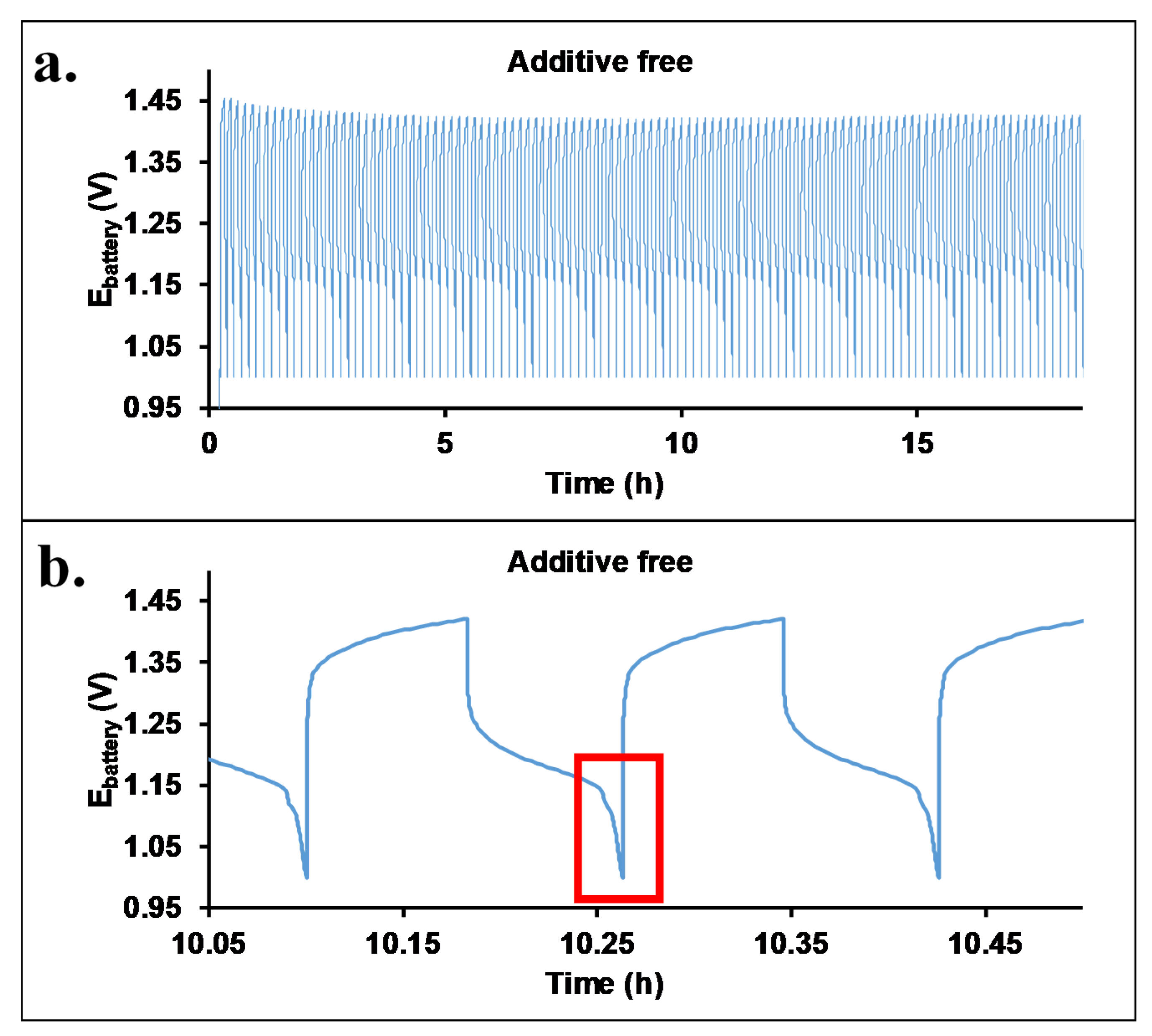

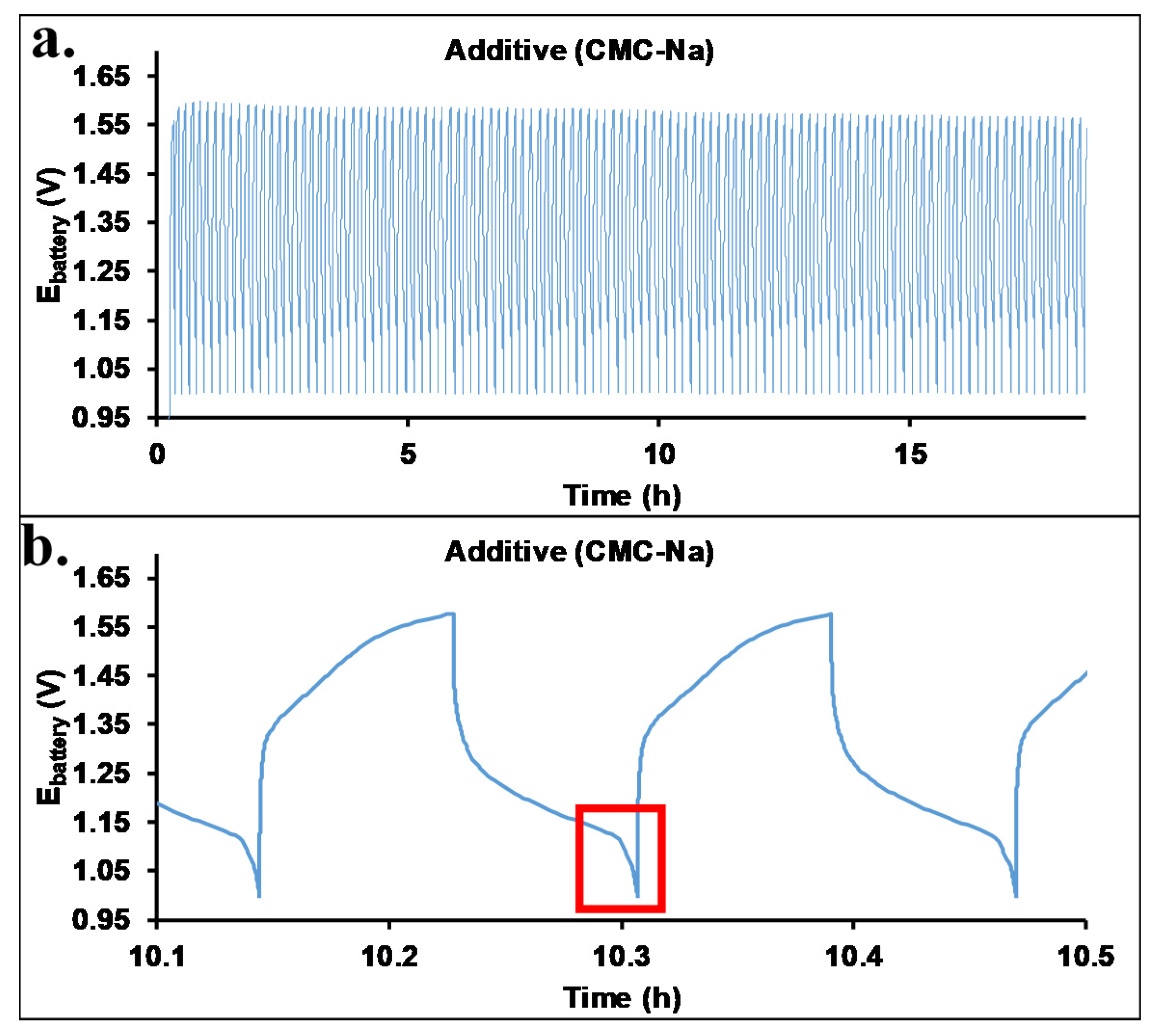

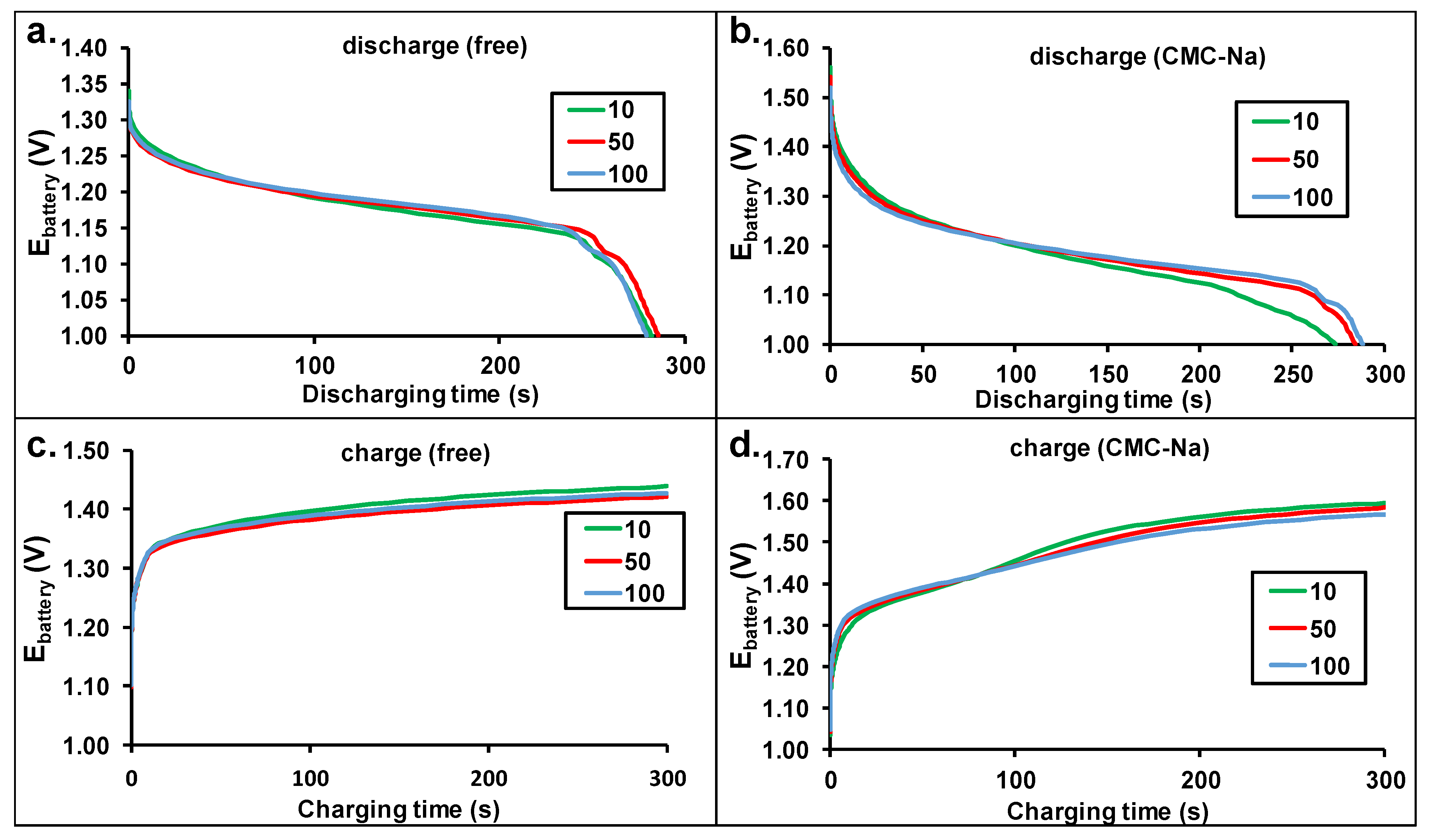
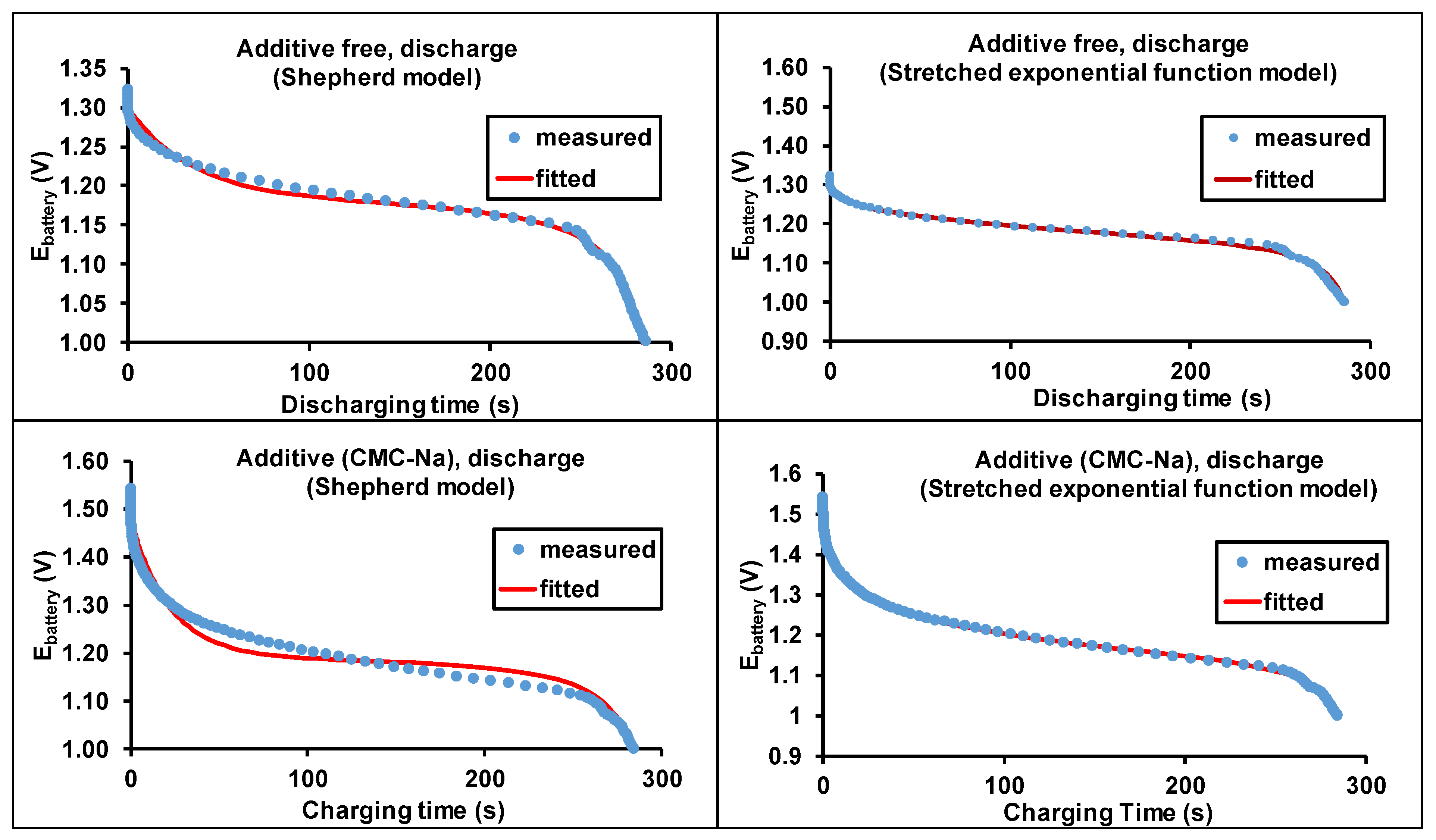
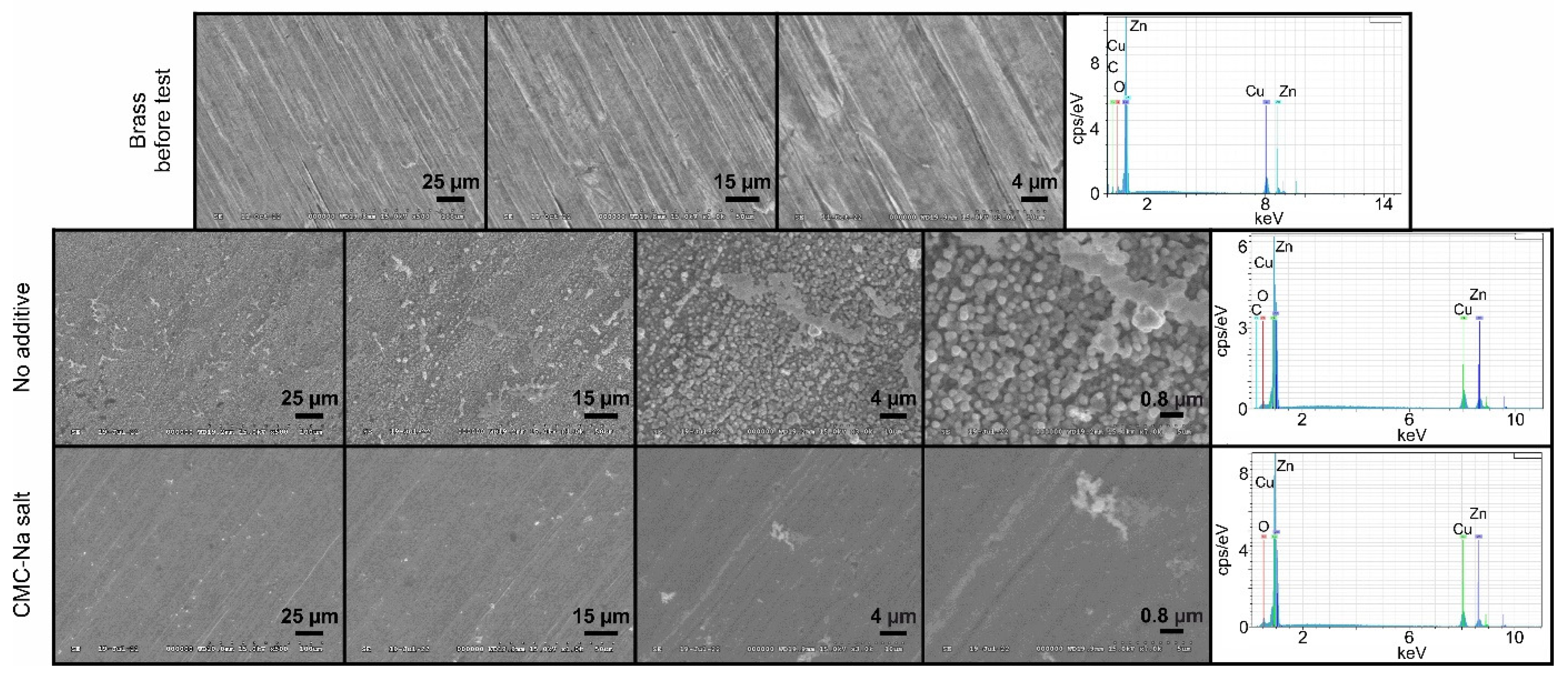
| Additive-Free | Additive (CMC-Na) | |||
|---|---|---|---|---|
| Shepherd model (Equation (1)) | K (Ω) | 0.67 ± 0.02 | K (Ω) | 0.75 ± 0.04 |
| R0 (Ω) | 7.97 ± 0.16 | R0 (Ω) | 21.19 ± 0.36 | |
| Q × 103 (Ah) | 1.32 ± 0.02 | Q × 103 (Ah) | 1.32 ± 0.02 | |
| A (V) | 0.11 ± 0.01 | A (V) | 0.28 ± 0.01 | |
| B (A−1h−1) | 6330 ± 570 | B (A−1h−1) | 10440 ± 720 | |
| E0 (V) | 1.32 ±0.02 | E0 (V) | 1.54 ± 0.02 | |
| Modified Shepherd model (Equation (2)) | K (Ω) | 0.60 ± 0.01 | K (Ω) | 0.50 ± 0.01 |
| R0 (Ω) | 12.03 ± 1.84 | R0 (Ω) | 30.42 ± 0.43 | |
| Q × 103 (Ah) | 1.32 ± 0.02 | Q × 103 (Ah) | 1.32 ± 0.02 | |
| A (V) | 0.19 ± 0.03 | A (V) | 0.50 ± 0.01 | |
| B (A−1h−1) | 1760 ± 1160 | B (A−1h−1) | 3400 ± 210 | |
| E0 (V) | 1.32 ± 0.02 | E0 (V) | 1.54 ± 0.02 | |
| µ | 0.38 ± 0.04 | µ | 0.36 ± 0.01 | |
Publisher’s Note: MDPI stays neutral with regard to jurisdictional claims in published maps and institutional affiliations. |
© 2022 by the authors. Licensee MDPI, Basel, Switzerland. This article is an open access article distributed under the terms and conditions of the Creative Commons Attribution (CC BY) license (https://creativecommons.org/licenses/by/4.0/).
Share and Cite
Nagy, T.; Nagy, L.; Erdélyi, Z.; Baradács, E.; Deák, G.; Zsuga, M.; Kéki, S. “In Situ” Formation of Zn Anode from Bimetallic Cu-Zn Alloy (Brass) for Dendrite-Free Operation of Zn-Air Rechargeable Battery. Batteries 2022, 8, 212. https://doi.org/10.3390/batteries8110212
Nagy T, Nagy L, Erdélyi Z, Baradács E, Deák G, Zsuga M, Kéki S. “In Situ” Formation of Zn Anode from Bimetallic Cu-Zn Alloy (Brass) for Dendrite-Free Operation of Zn-Air Rechargeable Battery. Batteries. 2022; 8(11):212. https://doi.org/10.3390/batteries8110212
Chicago/Turabian StyleNagy, Tibor, Lajos Nagy, Zoltán Erdélyi, Eszter Baradács, György Deák, Miklós Zsuga, and Sándor Kéki. 2022. "“In Situ” Formation of Zn Anode from Bimetallic Cu-Zn Alloy (Brass) for Dendrite-Free Operation of Zn-Air Rechargeable Battery" Batteries 8, no. 11: 212. https://doi.org/10.3390/batteries8110212





